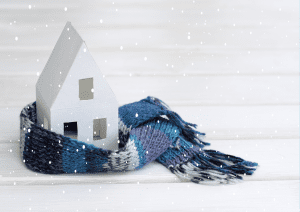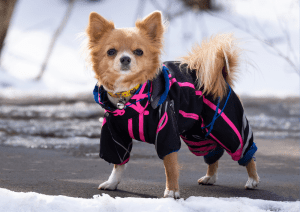
Preparing your home for the winter months is not just about cozying up indoors; it’s also about protecting your property. At Dave Ozubko Real Estate Team, we understand the importance of safeguarding your home against the chilly Edmonton winters. Let us guide you through the essential steps to winterize your house, ensuring a warm, secure, and hassle-free season.
Steps to Winterize Your Home in Edmonton
Seal Gaps and Cracks
The first line of defense against the cold is sealing gaps and cracks in your home. Even small openings around windows and doors can allow cold air to infiltrate your living space. Here’s how to tackle this crucial task:
- Check for gaps around windows, doors, and any other openings.
- Use caulk to seal these gaps, preventing drafts and heat loss.
- Pay special attention to areas where different building materials meet, as they are common sources of gaps.
- Don’t forget to examine the areas around pipes, vents, and electrical outlets for potential leaks.
Properly sealing gaps and cracks is just the beginning. The next step is to ensure your home is well-insulated.
Insulate Attic and Walls
Proper insulation is a cornerstone of a well-prepared home for winter. Good insulation not only keeps you warm but also reduces heating costs. Follow these steps to ensure your attic and walls are well-insulated:
- Check the current insulation in your attic and walls. Insulation levels are measured in R-values, and the recommended R-value for Edmonton is typically higher due to the cold climate.
- Add insulation if needed. You can choose from various types of insulation, including fiberglass, cellulose, or spray foam.
- Make sure there are no gaps or voids in your insulation, as they can compromise its effectiveness.
- Pay attention to the attic hatch or door, as this can be a significant source of heat loss if not properly insulated.
Now that your home is well-insulated, it’s time to ensure your heating system is in top condition.
Service Your Heating System
Your heating system is your best friend during the cold months, but it needs proper care to function efficiently. Here’s how to ensure it’s ready for the winter:
- Schedule a professional inspection and service for your heating system. This includes furnaces, heat pumps, or other heating sources.
- Regularly replace air filters. Clogged filters can reduce the efficiency of your heating system and increase your energy bills.
- Ensure that all heating vents and radiators are unobstructed to allow for proper airflow and heat distribution.
- Consider installing a programmable thermostat to optimize your heating system’s efficiency and save on energy costs.
With your heating system in good shape, it’s time to protect your pipes from freezing.
Protect Pipes
Frozen pipes can lead to expensive repairs and inconvenience. Prevent this by taking these measures:
- Insulate exposed pipes in unheated areas, such as the basement, attic, or crawl spaces.
- Use heat tape or cable to keep pipes warm in extremely cold conditions.
- During severe cold snaps, allow faucets to drip slowly. This prevents water from stagnating and freezing in the pipes.
- If you plan to be away from home for an extended period, consider shutting off the main water supply and draining the pipes.
Clean Gutters
Clean gutters are vital for proper drainage, especially during the winter months. Here’s how to tackle this task:
- Regularly clean out debris, leaves, and twigs from your gutters to ensure proper water flow.
- Inspect your downspouts to ensure they are clear and unobstructed.
- Consider installing gutter guards to minimize debris accumulation in the future.
- Ensure that the gutters are securely attached to your home to prevent damage from heavy snow or ice.
Trim Tree Branches
Winter snow and ice can weigh down tree branches, causing them to break and potentially damage your home. Follow these steps to prevent this:
- Identify trees near your home with branches that may pose a threat during winter.
- Trim these branches to reduce the risk of them falling onto your property.
- If a tree is dead or in poor health, consider removing it entirely to prevent any accidents.
Check Smoke and Carbon Monoxide Detectors
Ensuring the safety of your family is paramount, and functioning detectors play a crucial role. Here’s what you need to do:
- Test all smoke and carbon monoxide detectors in your home to make sure they are functioning correctly.
- Replace the batteries in these detectors at least once a year, or when they start beeping to signal low battery life.
- Install detectors in key areas of your home, including bedrooms, hallways, and the kitchen.
- Consider interconnected detectors that can communicate with each other, alerting you to dangers throughout your home.
Prepare Landscaping
While your garden might go dormant in the winter, there are steps to take to protect it and your home:
- Trim plants and shrubs to prevent winter damage and promote healthy growth in spring.
- Store outdoor furniture and garden tools to prevent weather-related damage.
- Consider winterizing your irrigation system if you have one.
Stock Emergency Supplies
Winter storms can lead to power outages and other emergencies. Be prepared with an emergency kit:
- Gather essentials like flashlights, blankets, non-perishable food, and a first-aid kit.
- Keep a battery-powered or hand-crank radio for updates during power outages.
- Regularly check and replenish your emergency supplies.
Schedule a Home Inspection
Consider a professional home inspection to address specific concerns and identify potential issues. Here’s why it’s a smart move:
- Inspectors can uncover hidden problems and provide tailored advice.
- Get insights on the overall condition of your home and potential improvements.
- Plan and budget for necessary repairs or upgrades.
FAQ: Should I Winterize My Home Even If I’m Not Going to Be Away?
Absolutely! Winterizing your home is essential, even if you’re not planning to be away for an extended period. Cold temperatures, snow, and ice can significantly impact your home, leading to issues like frozen pipes, ice dams, and heat loss. Proper winterization ensures that your home remains comfortable, safe, and energy-efficient throughout the winter season. Don’t wait until you encounter problems—take proactive steps to winterize your home, protecting both your property and your peace of mind.
Embrace Winter with Confidence: Your Edmonton Home is Ready
Preparing your home for the winter months in Edmonton is not just a necessity; it’s an investment in your comfort and peace of mind. By following the essential steps outlined, from sealing gaps and insulating to scheduling a professional home inspection, you’re ensuring that your home is resilient against the challenges of the season. These proactive measures not only safeguard your property but also enhance its overall longevity and functionality. As you embrace the coziness of your winter-ready home, you can do so with confidence, knowing that you’ve taken the necessary steps to make it a warm, secure haven in the midst of Edmonton’s winter. Stay warm, stay safe, and enjoy the season to the fullest in your well-prepared home.
Ready to make the most of your Edmonton winter? Contact the Dave Ozubko Real Estate Team at (780)-966-8227 today for personalized assistance with all your real estate needs. We’re here to help you find your dream home or successfully sell your property, making this season a smooth and enjoyable one. Don’t hesitate; let’s get started on your real estate journey now!
